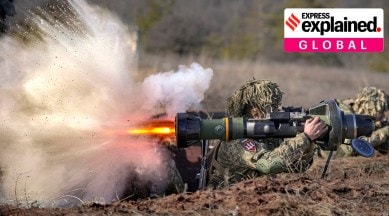Explained: What are cluster bombs and thermobaric weapons, allegedly used by Russia against Ukrainians?
Russia has been accused for using cluster bombs and vacuum bombs in the ongoing war against Ukraine. What are these? Is it legal to use these weapons?

Human rights groups Amnesty International and Human Rights Watch, and Ukraine’s ambassador to the United States Oksana Markarova on Monday (February 28) accused Russia of using cluster bombs and vacuum bombs in the ongoing war.
“They used the vacuum bomb today,” Markarova told reporters after a meeting with members of Congress. White House Press Secretary Jen Psaki said if Russia had indeed used these weapons, “it would potentially be a war crime”.
🗞️ Subscribe Now: Get Express Premium to access the best Election reporting and analysis 🗞️
What are cluster munitions?
According to the 2008 Convention on Cluster Munitions, a cluster munition means a “conventional munition that is designed to disperse or release explosive submunitions each weighing less than 20 kilograms, and includes those explosive submunitions”.
Essentially, cluster munitions are non-precision weapons that are designed to injure or kill human beings indiscriminately over a large area, and to destroy vehicles and infrastructure such as runways, railway or power transmission lines. They can be dropped from an aircraft or launched in a projectile that spins in flight, scattering many bomblets as it travels.
Many of these bomblets end up not exploding, but continue to lie on the ground, often partially or fully hidden and difficult to locate and remove, posing a threat to the civilian population for long after the fighting has ceased. The Convention on Cluster Munitions specifically identifies “cluster munition remnants”, which include “failed cluster munitions, abandoned cluster munitions, unexploded submunitions and unexploded bomblets”.
And what is a thermobaric weapon?
Thermobaric weapons — also known as aerosol bombs, fuel air explosives, or vaccum bombs — use oxygen from the air for a large, high-temperature blast. A thermobaric weapon causes significantly greater devastation than a conventional bomb of comparable size.
The weapons, which go off in two separate stages, can be fired as rockets from tank-mounted launchers or dropped from aircraft. As they hit their target, a first explosion splits open the bomb’s fuel container, releasing a cloud of fuel and metal particles that spreads over a large area.
A second explosion then occurs, igniting the aerosol cloud into a giant ball of fire and sending out intense blast waves that can destroy even reinforced buildings or equipment and vaporise human beings.
Is it legal to use these weapons?
Countries that have ratified the Convention on Cluster Munitions are prohibited from using cluster bombs. As of date, there are 110 state parties to the convention, and 13 other countries have signed up but are yet to ratify it. Neither Russia nor Ukraine are signatories.
Vacuum bombs are not prohibited by any international law or agreement, but their use against civilian populations in built-up areas, schools or hospitals, could, according to a report in the BBC, attract action under the Hague Conventions of 1899 and 1907.
Amnesty International said international humanitarian law prohibits the use of inherently indiscriminate weapons such as cluster munitions, Reuters reported. Launching indiscriminate attacks that kill or injure civilians constitutes a war crime, the report said.
Newsletter | Click to get the day’s best explainers in your inbox